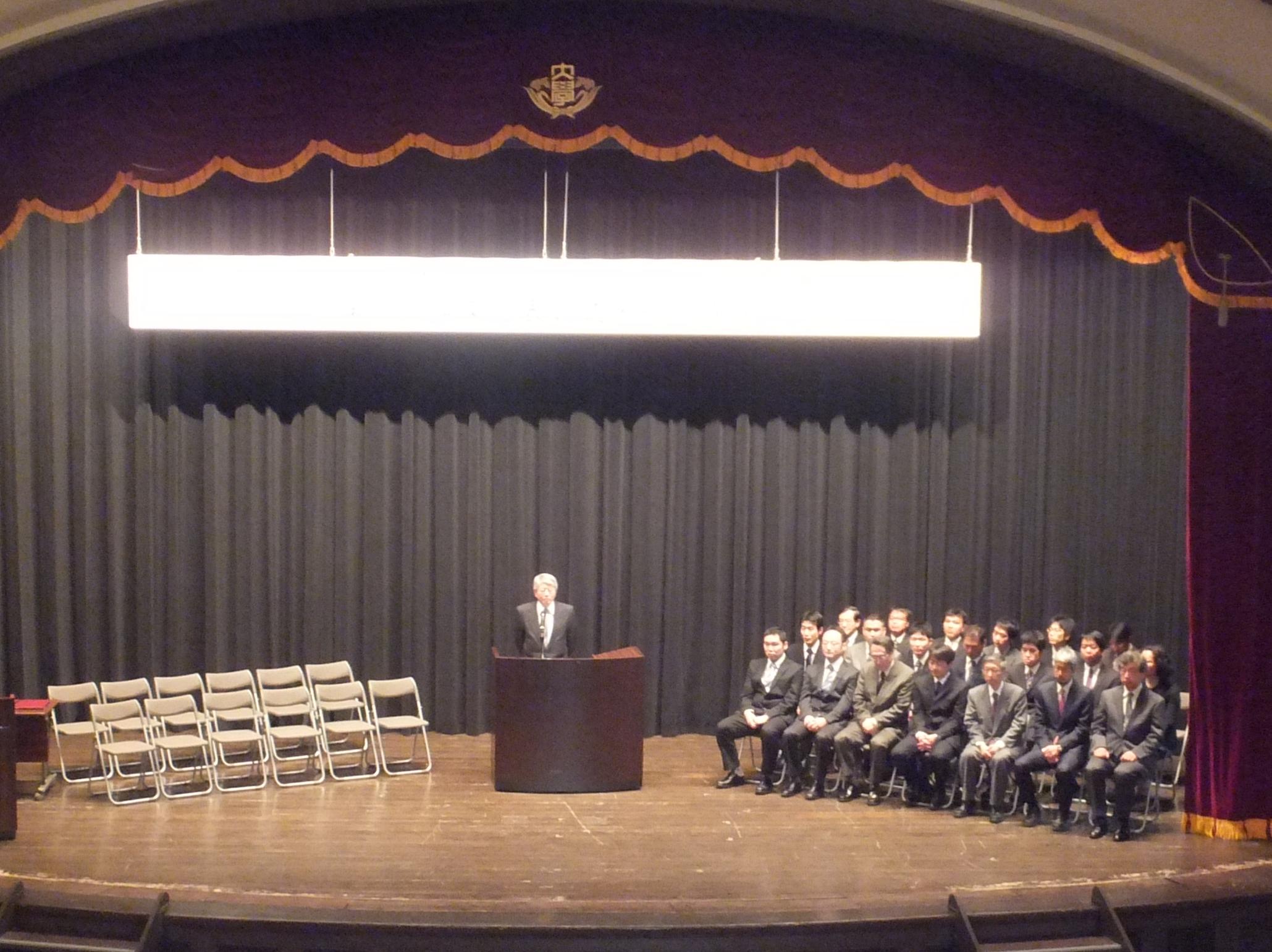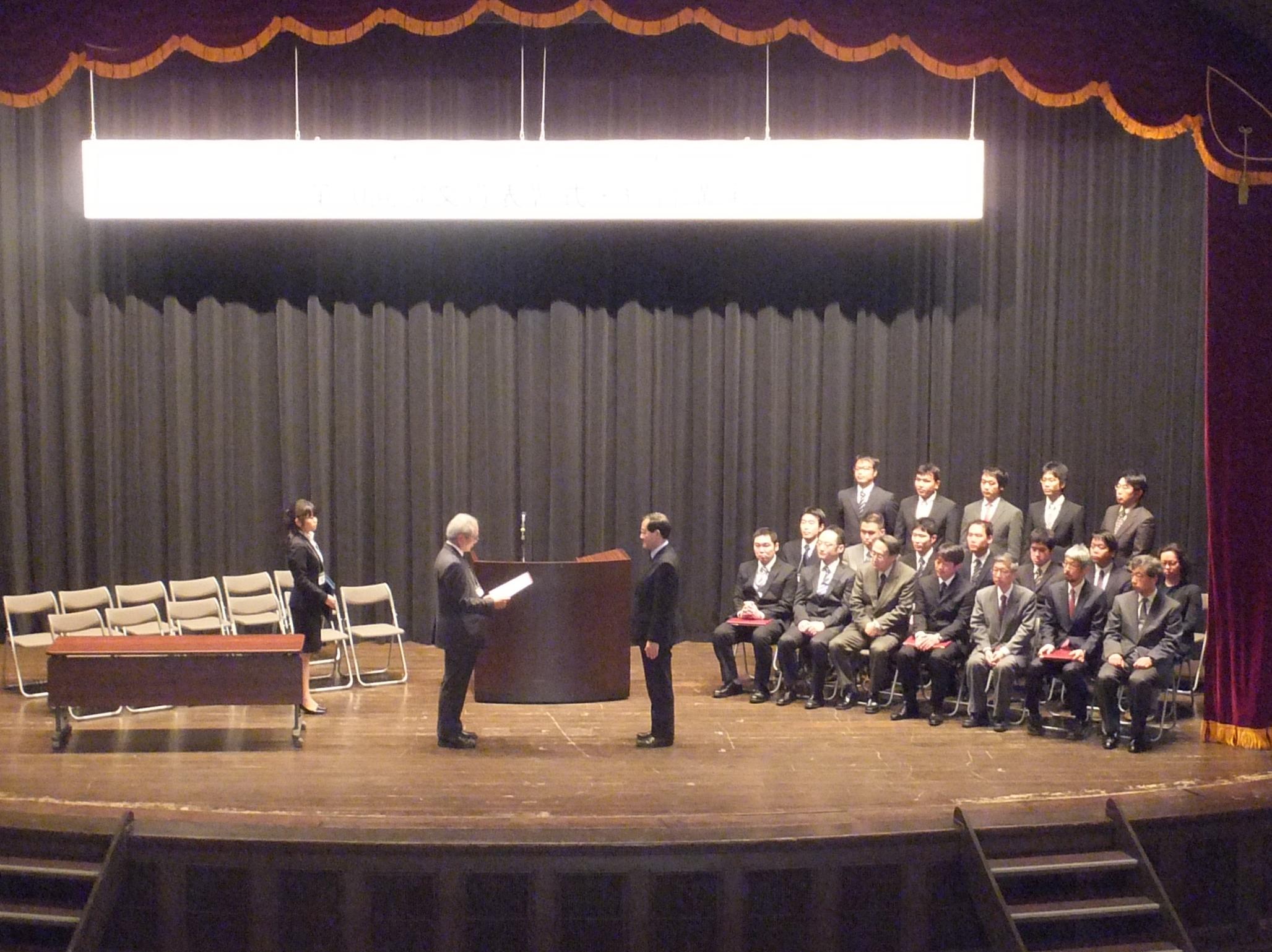The selection committee has chosen the following five papers for the 2015 award out of 21 nominations(18 papers)made by the editors of the two journals and representatives of the 19 divisions of the society.


| Title of Article | Energy Dependence of KN Interactions and Resonance Pole of Strange Dibaryons |
|---|---|
| Journal | Prog. Theor. Phys. (2010) 124 (3): 533-539 |
| Authors | Yoichi Ikeda,Hiroyuki Kamano and Toru Sato |
| Citation | The study of the anti-kaon (K) in finite nuclei and nuclear matter is one of the most important topics in hadron physics. Since Akaishi and Yamazaki pointed out the possibility of deeply bound K-nuclei in 2002, many theoretical and experimental attempts have been conducted to unravel the properties of K-nuclei and their relation to hadron interactions and the high density equation of state. So far, some candidates of the K-nuclei have been reported by experiments conducted in different facilities, although conclusive evidences have not been obtained yet. From a theoretical point of view, the ambiguity of the experimentally inaccessible KN interaction below the threshold and the theoretical difficulties surrounding the many-body problem of K-nuclei with KN-πΣ channel coupling prevent the researchers from making firm predictions even for the simplest 3-body system KNN. In this study, the precise position of the resonance poles of the KN N-πΣN system in the complex energy plane was calculated for the first time by using the Faddeev equation for the 3-body system with KN-πΣ channel coupling. The authors found that the different treatments of the energy dependence of the KN interaction lead to a large difference in the binding energy of the system. This study clarifies the reason why there have been large ambiguities of the theoretically predicted binding energy, which range from 10 MeV to 100 MeV, and is internationally recognized as an important work which affects future research. Studies of the K-nuclei are also related to the baryon resonance Λ(1405) located just below the KN threshold and are the key to understanding the exotic hadron states with the molecular-type structure. Furthermore, the production of K-nuclei is one of the major experiments in J-PARC, which attracts wide attention in the physics community. This study has made fundamental contribution to the physics of K-nuclei. |
| Title of Article | Breaking Tri-Bimaximal Mixing and Large θ13 |
|---|---|
| Journal | Prog. Theor. Phys. (2011) 126 (1): 81-90 |
| Authors | Yusuke Shimizu, Morimitsu Tanimoto, and Atsushi Watanabe |
| Citation | Experimental data on the solar neutrino deficit and atmospheric neutrino anomaly demonstrated the phenomenon of neutrino oscillation among different flavors. As a result, masses and mixing angles of three flavors of neutrinos have become a focus of interest of many researchers. Advances by accelerator-based neutrino experiments have facilitated the precise determination of these masses and mixing angles. Experimental data until now exhibit quite a different overall pattern relative to quarks; the tri-bimaximal mixing among three generations of neutrinos is a good first approximation. The tri-bimaximal mixing can be derived from non-Abelian discrete symmetry group A4, and predicts a vanishing mixing angle θ13 between the first and the third generations. However, recent neutrino experiments suggested a possibility of nonvanishing values of θ13. This article pointed out that the discrete non-Abelian symmetry group A4 allows a new contribution, which makes the mixing angle θ13 nonvanishing. Furthermore, the authors analyzed the mass and mixing angles quantitatively without referring to the details of the model. More recent experiments, such as T2K long baseline experiment, double Chooz reactor neutrino experiment, Daya Bay experiment, and REMO experiment, provide data showing the small nonvanishing value θ13 = 0.1, confirming the prediction of the article. Models with discrete non-Abelian symmetry group are attracting much attention of many researchers to explain the masses and mixing angles of neutrino. Among these researches include previous works of the authors. This article is highly valued for the prediction of the correct mixing pattern before experimental data are fully established. |
| Title of Article | Chern Numbers in Discretized Brillouin Zone: Efficient Method of Computing (Spin) Hall Conductances |
|---|---|
| Journal | J. Phys. Soc. Jpn. 74, pp. 1674-1677 (2005) |
| Authors | Takahiro Fukui, Yasuhiro Hatsugai, and Hiroshi Suzuki |
| Citation | The topological state of electrons in condensed matter is being focused on in theoretical physics to study the emergent properties of materials for future applications. An increasing number of researchers on this subject have begun using computer simulations with realistic models or first-principles electronic structure calculations. To determine the topological state in a simulation, it is necessary to compute a topological number called the Chern number. However, existing methods of numerical integration for that purpose have fundamental difficulty with gauge invariance and show very slow convergence with respect to the number of sampling points in the momentum space, which is a serious problem for computer simulation studies. In this paper, which is inspired by lattice gauge theory, the authors presented a new gauge-invariant description of the topological number with discretized Brillouin zone. It provides a simple and efficient method of computing the topological number with impressively fast convergence. Although 10 years have passed since its publication, the paper has recently received a great deal of attention, and the method has been widely and increasingly used throughout the world. The study is excellent both in the uniqueness of the idea and its contribution to research on topological insulators and superconductors. |
| Title of Article | Superconductivity and Structural Phase Transitions in Caged Compounds RT2Zn20 (R = La, Pr, T = Ru, Ir) |
|---|---|
| Journal | J. Phys. Soc. Jpn. 79, 033704 (2010) |
| Authors | Takahiro Onimaru, Keisuke T. Matsumoto, Yukihiro F. Inoue, Kazunori Umeo, Yuta Saiga, Yoshitaka Matsushita, Ryuji Tamura, Kazue Nishimoto, Isao Ishii, Takashi Suzuki, and Toshiro Takabatake |
| Citation | In heavy electron systems, which are typical examples of strongly correlated electron systems, the effect of electron-electron interaction is represented by an effective mass of quasiparticles. YbCo2Zn20 is known for its extraordinary heavy effective mass. A structural characteristic of this material is that the rare earth ion is encapsulated in a cage of sixteen Aluminum atoms. The structure of this material is often referred to as 1-2-20 structure. In some heavy electron systems, superconductivity is found at low temperatures. However, superconductivity had not been reported in the materials with the 1-2-20 structure. In the present paper, the authors report synthesis of single crystals of materials with the 1-2-20 structure. Among them, superconductivity is found in LaRu2Zn20, LaIr2Zn20, and PrIr2Zn20. The superconductivity of the lanthanum compounds seems to be of the conventional BCS type, while the effective mass of PrIr2Zn20 is very large. The ground state of the praseodymium ion in the cage of Zinc atoms is expected to be a non-Kramers doublet, and the origin of the large mass enhancement may be attributed to the degeneracy. Owing to the subsequent investigations, it was found that superconductivity appears in the ordered state of the quadrupolar moment. We conclude that the present paper opens the door to the new problem of heavy electron states due to the multipolar degrees of freedom, which may provide an interesting platform for the emergence of superconductivity. |
| Title of Article | Structural Quantum Criticality and Superconductivity in Iron-Based Superconductor Ba(Fe1-xCox)2As2 |
|---|---|
| Journal | J. Phys. Soc. Jpn. 81, 024604 (2012) |
| Authors | Masahito Yoshizawa, Daichi Kimura, Taiji Chiba, Shalamujiang Simayi, Yoshiki Nakanishi, Kunihiro Kihou, Chul-Ho Lee, Akira Iyo, Hiroshi Eisaki, Masamichi Nakajima, and Shin-ichi Uchida |
| Citation | The discovery of high-Tc iron pnictide and chalcogenide superconductors has been one of the most exciting recent developments in condensed matter physics. Although there is general consensus on the unconventional pairing state of these superconductors, several central questions remain, including the role of magnetism and orbital degrees of freedom in the superconductivity. A common feature of this system is that the (tetragonal-orthorhombic) structural and antiferromagnetic transition lines closely follow each other. The superconducting transition temperature often reaches a maximum at the endpoint of these transition lines, indicating the importance of the quantum critical fluctuations associated with the quantum critical point. Therefore, it is critically important to clarify which factor plays a major role in superconductivity, magnetic, or orbital fluctuations. In this article, by the systematic ultrasound measurements on Ba(Fe1-xCox)2As2, the authors report that shear modulus C66, which is directly related to the tetragonal- orthorhombic transition, shows softening in a wide range of the x-T phase diagram. In particular, the largest softening occurs at the end point of the structural transition line, suggesting the presence of quantum critical fluctuations of orbital degrees of freedom. Moreover, the temperature dependence of 1/C66, which characterizes the structural instability, bears striking resemblance to that of magnetic susceptibility near the quantum critical point. These results indicate an intimate relationship between magnetic and orbital quantum critical fluctuations. Although the mechanism of high temperature superconductivity of iron-based compounds is still controversial, this article is highly values for demonstrating the important role of the orbital degrees of freedom. |
